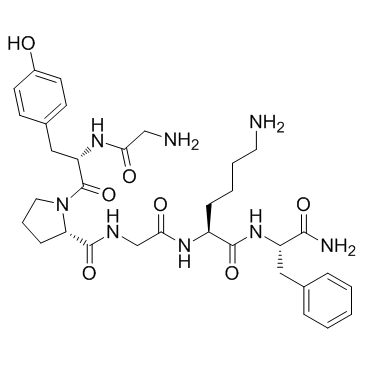PAR-4 (1-6) amide (mouse) trifluoroacetate salt
Modify Date: 2025-08-25 15:39:42

PAR-4 (1-6) amide (mouse) trifluoroacetate salt structure
|
Common Name | PAR-4 (1-6) amide (mouse) trifluoroacetate salt | ||
|---|---|---|---|---|
| CAS Number | 245443-52-1 | Molecular Weight | 666.76800 | |
| Density | N/A | Boiling Point | N/A | |
| Molecular Formula | C33H46N8O7 | Melting Point | N/A | |
| MSDS | N/A | Flash Point | N/A | |
Use of PAR-4 (1-6) amide (mouse) trifluoroacetate saltProtease-Activated Receptor-4 is the agonist of proteinase-activated receptor-4 (PAR4). |
| Name | h-gly-tyr-pro-gly-lys-phe-nh2 |
|---|---|
| Synonym | More Synonyms |
| Description | Protease-Activated Receptor-4 is the agonist of proteinase-activated receptor-4 (PAR4). |
|---|---|
| Related Catalog | |
| In Vitro | GYPGKF-NH2 significantly reduces the agonistic potency of AYPGKF-NH2 by 25-fold[1]. GYPGKF-NH2 (500 μM) does not cause contraction or relaxation of the guinea pig IAS strips[2]. |
| References |
| Molecular Formula | C33H46N8O7 |
|---|---|
| Molecular Weight | 666.76800 |
| Exact Mass | 666.34900 |
| PSA | 252.07000 |
| LogP | 1.91440 |
| Storage condition | 2-8℃ |
| par-4 agonist amide |
| gypgkfamide |
| gypgkf-nh2 |
| protease-activated receptor-4 agonist amide |
| h2n-gypgkf-amide |
| GLY-TYR-PRO-GLY-LYS-PHE-NH2 |
| Protease-Activated Receptor-4 |